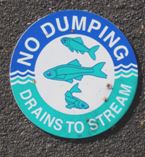What is Stormwater runoff?
Stormwater runoff is the rain, snow, hail or other precipitation that falls from the sky and flows over the ground rather than infiltrating into the soil. Before buildings, roads, parking lots and other impervious surfaces were built rain could soak into the ground and the amount that ran off to streams was much less.

 Stormwater runoff does not go to a sanitary sewer treatment plant. In a typical urban environment, Stormwater flows across rooftops, lawns, driveways and streets. Along the way the water picks up a variety of pollutants including oil, grease, yard chemicals, pet waste, silt, and debris. It then enters storm sewer catch basins and piping or ditches, from which it dumps into local creeks, Bear Creek, the Rogue River, and finally the Pacific Ocean without going through a treatment plant. To help promote the fact that Stormwater is not treated, RVSS has worked with its jurisdictions to make sure all storm drains are stamped or labeled “No Dumping, drains to stream”.
Stormwater runoff does not go to a sanitary sewer treatment plant. In a typical urban environment, Stormwater flows across rooftops, lawns, driveways and streets. Along the way the water picks up a variety of pollutants including oil, grease, yard chemicals, pet waste, silt, and debris. It then enters storm sewer catch basins and piping or ditches, from which it dumps into local creeks, Bear Creek, the Rogue River, and finally the Pacific Ocean without going through a treatment plant. To help promote the fact that Stormwater is not treated, RVSS has worked with its jurisdictions to make sure all storm drains are stamped or labeled “No Dumping, drains to stream”.